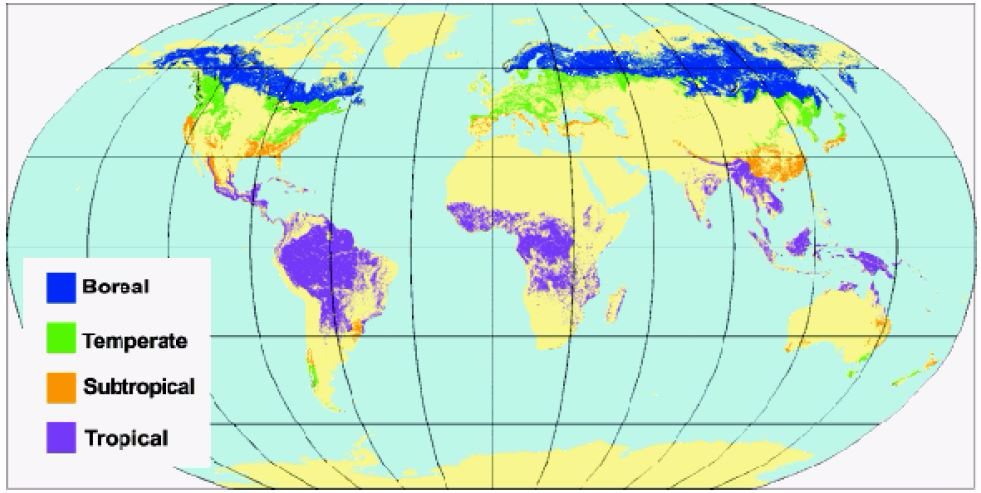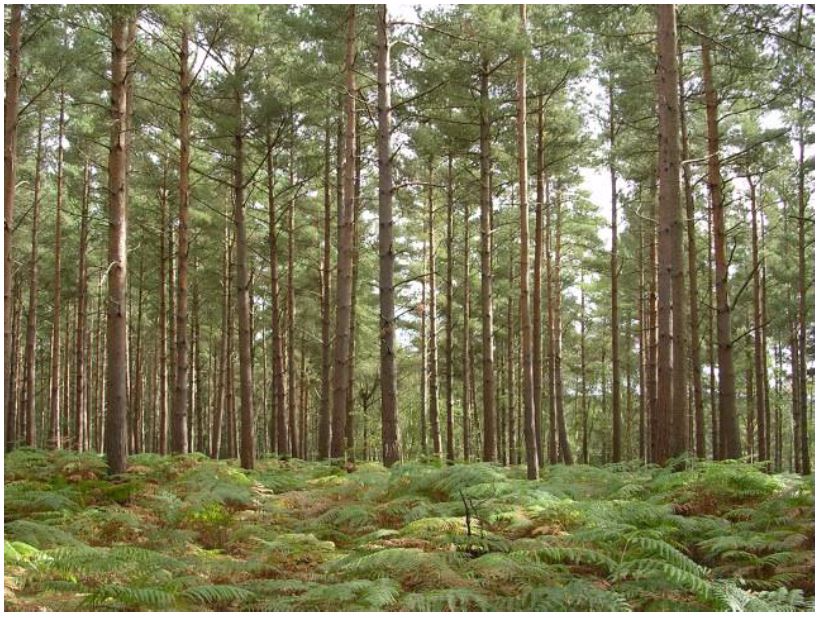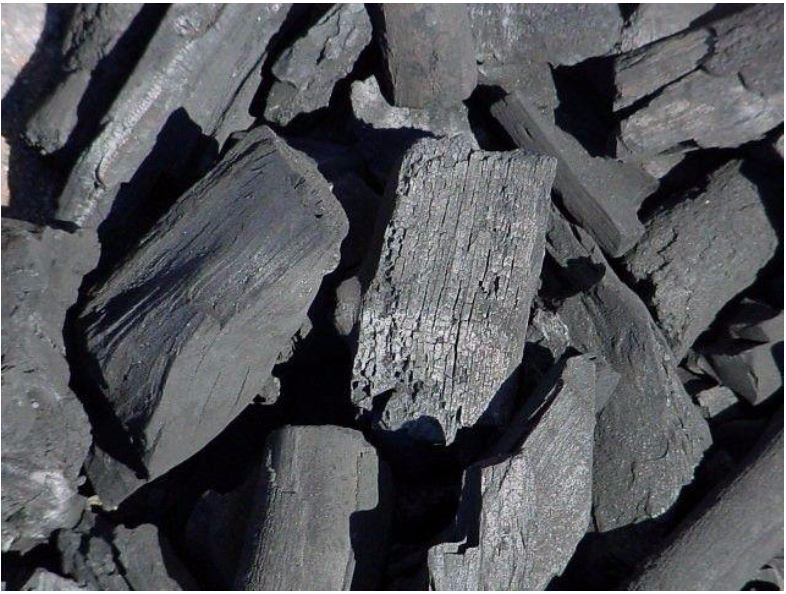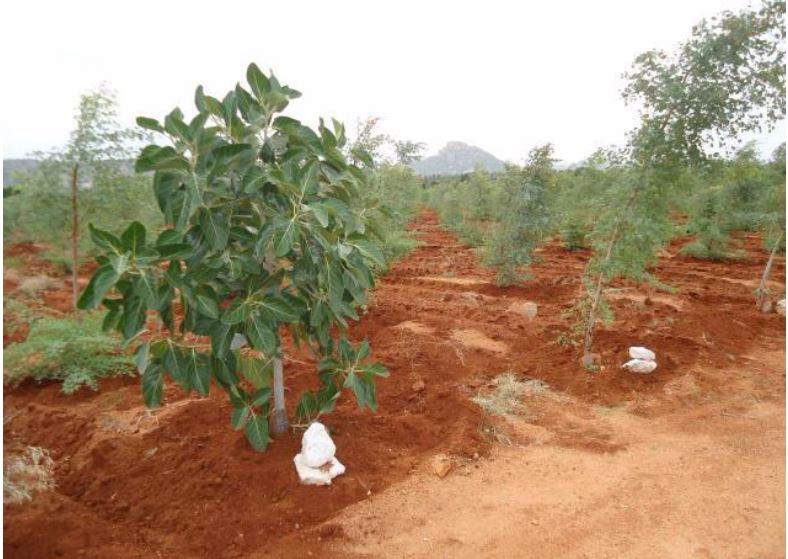
SUSTAINABLE USE OF FOREST RESOURCES
Types of Forestry Resources
Types of Forests
Identify types of forests
Natural forests
Some characteristics of natural forests include the following:
- Trees of different types grow together.
- Most of the trees are hardwood.
- The trees in these forests are indigenous to the area.
- There is dense or thick undergrowth.

A natural forest
Distribution of Forests by Type
Locate the distribution of forests by type
Due to factors such as climate and tree species, natural forests can further be subdivided into the following broad categories.
- Tropical rainforests: They are found around the equator, between 23.5°N and 23.5°S. Trees in the tropical rainforests are tall and often take a very long time to mature. They consist of indigenous trees which are typically broad-leaved, and they contain thick undergrowths of shrubs and other vegetation.
- Temperate forests: These forests occur in the mid latitudes of both hemispheres. There are four distinct seasons in temperate deciduous forests and precipitation falls throughout the year, as rain in the spring, summer and fall and snow in the winter. The forest floor in temperate forests supports mosses, ferns and wild flowers. Maple, oak and birch trees are some examples of the deciduous trees that dominate these forests. There are also small numbers of evergreen trees such as pines and fir.
- Coniferous forests: Coniferous forests are typically found in coastal areas with mild winters and heavy rainfall or in in-land mountainous areas with mild climates with temperature that fluctuates little throughout the year. Evergreen conifers dominate these forests. They are characterized by evergreen, need-leaved trees, with little undergrowth and tall trees which take very long time to mature. Dominant tree species found in coniferous forests include cedar, cypress, Douglas fir, pine, spruce and redwood. Some deciduous trees such as maple, and mosses and ferns are common in coniferous forests.
- Boreal (taiga) forests: These are the northernmost forest type and are found between 50°N and 60°N. Boreal forests are characterized by long winters and short summers. Most precipitation is in the form of snow. Trees are mostly evergreen and include species such as spruce, fir and pine.

Distribution of natural forests
Planted forests
Some characteristics of plant forests include.
- Trees are mainly of one species
- Trees are planted in rows in order to make harvesting work easy.
- Trees are may or may not be indigenous to the area
- Most of the trees are softwood.

A planted forest
Factors for Distribution of Forests
Explain factors for distribution of forests
Forest distributions are affected by a number of factors which include the following:
- Soil: Different types of soil offer various types of vegetation. For example, a damp and marshy soil will favour growth of types of trees such as mangroves, which are generally found on the coastal areas of the tropics or subtropics. On the other hand, sandy soils located in dry desert areas will support prickly bushes and cactus where the aim of the plant is to conserve water.
- Rainfall: Water is an essential component of all living organisms. Trees need water for various physiological functions such as photosynthesis and cooling. Hence, it is essential for growth and development of any particular vegetation. Forests thrive well in areas that receive sufficient rainfall which is evenly distributed throughout the year.
- Temperature: The warm and wet equatorial climate supports the growth of mainly huge, tall, deciduous trees. The cooler temperate climate supports needle-leaved trees which are adapted to that particular climate. The moderately hot tropical climate supports a variety of softwood and hardwood trees which thrive best in the tropics.
- Relief: Relief refers to variation in altitude in an area. Differences in altitude along the slope of a mountain bring about differences in the type of forests along a mountain slope. For example, you will always find dense forests on the foot of Mount Kilimanjaro. As you move up from the foot of the mountain, the vegetation type and density changes gradually. At a height ranging between 1800 and 2800 m, there is the tropical rainforest, followed by the temperate forest at around 4000 m. Between 3000 and 3500 m, the forest is dominated by scanty vegetation, with patches of a bamboo forest.
- Aspect: In physical geography, aspect generally refers to the horizontal direction to which a mountain slope faces. The slope of a mountain facing the direction of prevailing winds (windward side) will always receive higher amounts of rainfall than the slope facing the opposite side (leeward side). For this reason, dense forests will always grow on the windward side, due to abundant rainfall, while the leeward side will consist of scanty and poor vegetation.
- Drainage:If the soil has too much water, plants cannot get enough oxygen from the soil. This will affect root respiration and the plants may eventually die. On the other hand, plants cannot grow well if they do not have healthy roots for absorbing water from the soil. So, the proper balance of plant health, water and air is necessary for maximum plant growth and development.Well drained soils support growth of a variety of big trees compared to water-logged and swampy lowland. However, few plants such as mangrove can thrive in shallow sea shores which are more or less permanently covered by water.
- Human activities:Human activities such as clearing the vegetation to get land for agriculture or settlement greatly affect the distribution of forests. Most of the natural forests of the world have been cleared by man. In some parts man has planted forests (artificial forests) on bare lands or in place of natural forests.
Importance of Forestry Resources
The Importance and Values of Forests in Social and Economic Life
Describe the importance and values of forests in social and economic life
Forests play an important role in our daily lives. A variety goods and services that we use to simplify our lives are derived from forests. It is not possible to sum up the importance of forests in a few words. Forests impact our lives in so many ways. They are of great social and ecological significance to mankind.
The following are some of the reasons why forests are very important:
- Forests are of immense economic importance to us. For example, plantation forests provide humans with timber and wood, which is exported and used in all parts of the world. Timber is used in building and construction, making furniture, tool handles and for ship building, among other various uses.Trees also provide tourism income to inhabitants (people living in or close to forests) when people pay a visit to see the beauty of nature (ecotourism).

Timber
- Forest trees are valuable sources of wood and charcoal which are used as fuel in many parts of the world. In many developing countries, Tanzania inclusive, more than 80% of total energy (fuel wood and charcoal) consumed by people and industry is derived from forests.

Charcoal
- Wood pulp which is used to make paper is derived from a variety of softwood trees.
The Importance of Forests in Ecological and Environmental Balance
Explain the importance of forests in ecological and environmental balance
The following are the importance ofForests in Ecological and Environmental Balance
- Forests serve as habitats to a diversity of animal species and they also serve as settlements for many different wild tribes. Certain tribes such as the Hadzabe and Tindiga in Tanzania live and earn their living in forests. They live by gathering fruits from the forests, hunting wild animals for meat, and harvesting honey. They get all their daily needs from the forests.
- Forests protect the watersheds (water catchments). Many rivers and streams have their sources indense forests. This is because of the heavy rainfall often experienced in these areas. So forestsserve as sources of rivers and springs, the water resources that are needed by man for livelihood.The Amazon is by far the largest watershed and largest river system in the world occupying over 6million square kilometres. Over two-thirds of all the fresh water found on Earth is in the AmazonBasin's rivers, streams, and tributaries.
- Forests help in maintaining the water cycle. When the rain falls some of the water is absorbed byplants in the soil through roots. The water absorbed by trees is then released into the atmospherethrough plant leaves (transpiration) where it condenses to form a mass of tiny water droplets(clouds). After these water droplets have gained enough size and weight, they fall down as rainunder the influence of gravitational pull.
- A variety of chemical substances are obtained from the forest trees. The barks of mangrove treesthat are common along the coast of East and West Africa provide tannin which is used for tanningleather. Chicle, a milky sap obtained from the bark of the zapote tree from the tropical rainforest ofCentral America is a raw material used for making chewing gum. Wild rubber and balata juicesused for making machinery belting are also obtained from tropical forests.
- Forests play the most important role in environmental conservation. Trees give out moisture via transpiration, a phenomenon which increases the atmospheric moisture content and hence rainfall. The air in and around forests is cold for most of the time, thereby providing a pleasant micro–climate. Acer saccharum (Sugar maple) is best known for being the primary source of maple sForest trees also serve as wind breaks, thus helping to reduce soil erosion by wind. Trees also prevent soil erosion by providing a soil cover that offers protection to the soil against the impact of direct rain drops. In this way, they both protect the soil from water erosion and loss of water via evaporation of moisture from the soil.
- Climate control and atmospheric purification is crucial for human existence. Trees and soils help regulate atmospheric temperatures through a process called evapotranspiration. This helps to stabilize the climate. Additionally, they enrich the atmosphere by absorbing bad gases (for example, carbon dioxide and other greenhouse gases) and producing oxygen. Trees also help to remove air pollutants.
Important Areas of Forest Products, their Transport and Use in the World
Important Countries in Timber Production
Identify important countries in timber production
Because forests exist in almost every country, they are equally exploited for their products. Many countries produce, use and export a variety of forest products. The following are the world’s leading countries in production of forest products.
| Product | Leading countries |
| Timber and wood fuel | Russia, USA, Brazil, China, Canada, Indonesia, Japan, Sweden, Nigeria, France, Finland, Germany |
| Timber from hardwoods | Indonesia, Brazil, India, China, USA, Russia, Nigeria, Tanzania, Malaysia, Philippines |
| Timber from softwoods | Russia, USA, Canada, China, Sweden, Finland, Brazil, Germany, Japan |
| Wood pulp | USA, Canada, Russia, Japan, Sweden, Finland, France, Germany, China, Brazil, Norway, New Zealand. |
| Newsprint | Canada, USA, Japan, Russia, Sweden, China, Finland, Germany, Norway, UK |
| Rubber and gum | Brazil, Nigeria, Borneo (Indonesia) Central America |
| Resin, pith, tar, turpentine | Southern USA, France, Russia |
| Cork | USA (California) Portugal, Spain Morocco |
There are many forest products which include the following:
- Tannin, which is obtained from the hemlock tree of North America and Europe, oak and chestnut of the temperate hardwoods, quebracho of Southern Brazil, Paraguay and Northern Argentina, wattle tress of East, Central and South Africa and mangrove from the tropical coastlands.
- Palm and creeper products, such as:(i) palm oil; (ii) coconuts; (iii) mat and basket weaving materials from many varieties of palms such as pandamus and raffia; and (iv) furniture, basketry and weaving materials from bamboo and creepers like rattan.
- Medicinal materials, such as:(i) quinine from cinchona tree;(ii) cocaine from coca plant; and(iii) camphor from the camphor tree.
- Fruits and spices
The Means of Transportation and Problems of Timber Transportation in the World
Explain the means of transportation and problems of timber transportation in the world
Harvesting and transportation of timber faces many challenges in many ways. The movement of logs and timber from the forests to sawmills or market faces many challenges.
The logs are pulled by tractors or lorries out of dense forests to saw mills or markets. Where sawmills are located far away from the forests, they are loaded and transported to sawmills by lorries. The sawn timber is then transported to local markets for sale or exported overseas.
In Tanzania, timber and logs are transported by lorries from production areas (mostly Iringa, Mbeya, Mtwara, lindi and Ruvuma regions) to Dar es Salaam where they are sold or shipped to overseas markets.
Within the tropics, the major problem is moving logs from deep in the heart of the forest to the mills. The areas where valuable trees are found are undeveloped, impenetrable, and remote and they often lack access roads. The valuable tree species are also scattered within the forests. This means covering large areas of the forest harvesting the desired tree species, a situation which makes transportation of logs very difficult. Many tropical trees have big trunks and are heavy. This makes it impossible to transport them by floating on rivers. Bad enough, some rivers that could be used to transport the logs are interrupted with waterfalls and rapids, and are covered with dense floating vegetations such as water hyacinth.
Timber transportation in temperate forests is much easier. The tree species grow in pure stands. This means that one area is covered by one species of trees all of which are almost of the same age. The tree trunks are smaller and lighter than their tropical counterparts. So the logs can easily be floated downstream to the saw mills which are located along rivers. In comparison to tropical forests, transportation problems are minimal. The logs are pulled along the partly frozen ground in winter by tractors and caterpillars onto the rivers. Also, there is little undergrowth in the forests. So transportation is not hindered as it is the case in the tropical forests.
Problems Associated with Forestry Resources Harvesting
The Problems Facing Forestry Resources Harvesting
Describe the problems facing forestry resources harvesting
Over the last fifty years about half the world’s original forest cover has been lost. The most notorious cause for this loss is unsystematic use of forest resources by man. When we take away the forest it is not just the trees that go. The entire ecosystem begins to fall apart with dire consequences for all of us. The following are some of the problems (effects) associated with harvesting of forest resources:
- Cutting down trees indiscriminately exposes the soil to agents of erosion. If corrective measures are not taken in time, the soil may get eroded badly to such an extent that it can turn into badlands or even semi-arid.
- Many forests form water catchments. Clearing the forests from such places can lead to destruction of water sources, a fact which can cause drought and hence water shortage and eventually aridity.
- Cutting down trees carelessly, without taking actions to replant the new ones, can eventually lead to change in climatic conditions leading to drought and famine. It also deprives the animals of the habitat.
- Trees also help to absorb carbon dioxide gas from the atmosphere. So reduction of the forest cover through deforestation can cause accumulation of carbon dioxide in the atmosphere and result in greenhouse effect, which causes global warming.
- Uncontrolled harvesting of forest resources eventually leads to scarcity of forest resources. This may, in turn, lead extinction of some forest species.
- Forests are a habitat to a variety of animal species ranging from crawling insects to flying birds; and extremely small organisms to very big animals. Uncontrolled tree harvesting interferes with the ecological balance of the forest flora and fauna. In time, some of the animals migrate to other regions where the habitat is unfavourable or die leading to species extinction.
- Some tree species are very rare and unique to the region. If tree harvesting is not done with care, some of the rare plant species would become extinct, a fact that would negatively affect the ecosystem balance.
Ways to Address Problems Facing Forests in the World
Describe ways to address problems facing forests in the world
The problems facing forests in the world can be addressed through sound management and conservation of forest resources. There are a number of measures that be taken effectively to manage forests, which include the following:
- Carrying out researches to determine the growth requirement of certain tree species so that correct species are planted in the correct soil and climatic conditions for optimum growth. This can also involve the development of tree species that withstand harsh conditions and which take a short time to mature.
- Educating the people on the importance of conserving forests and how the destruction of the forest cover can have negative impacts on their livelihood. This can be done via mass media, posters, seminars and introduction of forest conservation education in school and college curricula.
- Encouraging the use of alternative energy sources instead of relying heavily on charcoal and firewood as the major sources of fuel for homes and industries. The alternative and clean energy sources include solar power, hydroelectric power, wind energy, biomass energy (biogas), oil kerosene and natural gas.
- Encouraging the use of energy–efficient devices which consume a little amount of energy examples of these devices include energy–serving bulbs and stoves which can be purchased from local shops. Use of devices that consume less energy not only help to conserve energy but also lowers electricity bills.
- Enacting and enforcing laws that govern conservation of forest resources. This can involve setting rules and guidelines about selective felling of trees, that is, rare species such as the mninga should only be harvested after getting a permit from forest officer.
- Where new forests are established, trees should be planted in blocks. Planting should be done in phases such that trees in different blocks mature and are harvested at different periods. When trees in a given block mature, they are cut down and the new ones are planted to replace them. This will ensure continuity in supply of timber as well as conserving the soil. The forestry department should supply seed and or seedling to people to encourage them to plant more trees. Also people should be encouraged to plant indigenous tree species so that the trees do not become extinct.
- The forestry department should be very keen in detection and control of pests and diseases that attack the planted and natural forests to ensure constant supply of timber and other forest resources.
- Planting trees where other trees have been cut down (reforestation) and planting trees where there never existed any tree before (afforestation). People should be encourage to take part in tree planting through campaigns such as “Kata Panda Mti”, a campaign aiming at planting trees to replace those cut down. The forestry department should provide seedlings and seeds to people and everybody must participate to plant trees on the Environment Day (1st April each year), a day which is celebrated in Tanzania by planting trees countrywide.
- The government should enact and enforce laws in order to manage forests and protect them against destruction. This may be done by setting aside some forests and declaring them as protected areas. Anyone caught harvesting trees from the protected forests should be heavily fined, jailed or both. Forest guards should be deployed to patrol the forests.
- Population control should be encouraged in the countries to reduce pressure on the forest resources and the land in general. The ever growing human population is becoming a threat to forest resources as people’s requirement of timber, firewood and other forest resources is in on the increase.
Forest conservation involves the following measures:
- Afforestation. This is the planting of new trees in areas where trees never existed before. Arid and semi arid regions should be planted with trees to control soil erosion. Countries like Israel have managed to make the desert land productive by planting trees.
- Reforestation. This refers to planting of trees in an area previously occupied by a forest but which has been cleared off. This will help to replace the trees that have been cut so as to conserve the soil and the environment in general.
- Involving the local communities in forest conservation is very crucial. This will make them support forest conservation initiatives. People may be allowed to plant crops in areas close to forests and at the same time serve as guards who take care of the forests. This practice has two benefits: helping to clean the forests and preventing illegal forest resource harvesters.Farmers should be encouraged to plant trees along with crop cultivation (agroforestry). It is important to note that measures that aim at management of forests are also the measures that aim at forest conservation, such as legislation and creation of forest reserves (protected areas).

Afforestation
- READ TOPIC 5: Sustainable Mining



No comments:
Post a Comment